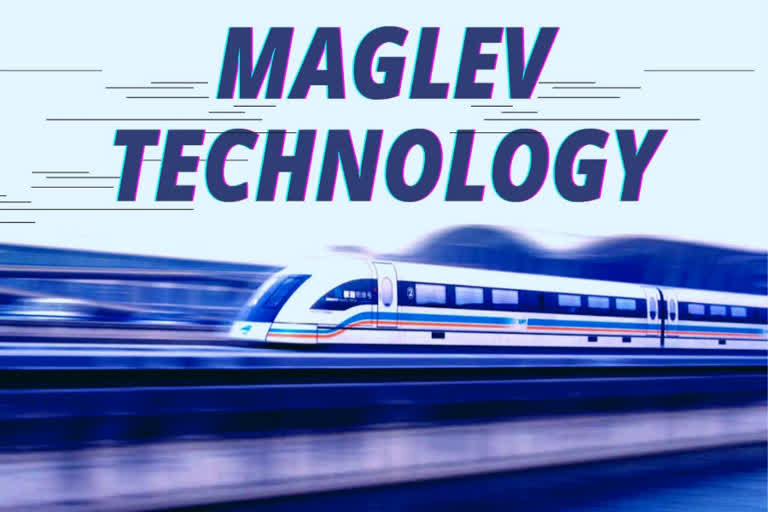Japan and China are racing to build a new type of ultra-fast, levitating train, seeking to demonstrate their mastery over technology with big export potential.
Magnetic levitation, or maglev, trains use powerful magnets to glide along charged tracks at super-fast speeds made possible by the lack of friction. A handful of short distance and experimental maglev trains are already in operation, but Asia's two biggest economies are vying to develop what would be the world's first long-distance intercity lines.
On one side is Central Japan Railway Co.'s 9 trillion yen ($86 billion) maglev that's expected to connect Tokyo and Osaka by 2037. On the other is China's 100 billion yuan ($15 billion) on-again, an off-again project that will run between Shanghai and the eastern port city of Ningbo. After several false starts, it's now forecast to be completed by around 2035. Japan's is more expensive largely because of the amount of excavation that will be required to tunnel through the mountainous countryside.
If Japan and China are able to unveil their long-distance projects successfully by their due dates, it should give them a leg up when they look to export the next-generation technology, rail experts say. At stake is a share of the estimated more than $2 trillion global markets for rail infrastructure projects.
"Maglev technology has huge export potential, and China and Japan's domestic projects are like shop windows into how the technology could be successfully implemented abroad," said Christopher Hood, a professor at Cardiff University who's studied and written a book about Japan's shinkansen.
Japan, the creator of the world's first bullet train, or shinkansen, has long been a top supplier to global fast-rail projects. Former Prime Minister Shinzo Abe targeted infrastructure exports including high-speed rail technologies as a key plank of economic growth.
But over the past decade, Chinese competitors, often willing to supply parts and know-how for cheaper, have been catching up. In 2015, Japanese suppliers lost out to Chinese rivals in a bid to build Indonesia's first high-speed railway from the capital Jakarta to Bandung in West Java. Japan was eventually asked to rejoin the project after it began to face significant delays.
Japan is a "strong rival" in developing regular bullet and high-speed maglev trains, according to an article that appeared in July in state-backed China Daily and that quoted a professor who specializes in railways. This "tough reality" has pushed China to make quick breakthroughs in developing maglev trains "to ensure the country has an adequate market share in both future domestic and global markets," the report said.
The maglev line that will connect financial hub Shanghai and Ningbo, via Hangzhou, is part of a plan by China's Zhejiang provincial government to inject 3 trillion yuan into building out the province's rail lines.
Also Read: Solo, a single-passenger all-electric vehicle from ElectraMeccanica
"There's the sense that in the technological world, Japan is falling further and further behind China, so if it can realize this new technology first, it would be an issue of immense national pride," Hood said. He points to China's recent development of a high-speed train prototype that can run on different track gauges, something Japan has been trying to master with varying degrees of success for several years.
In 2016, the Abe government approved a 3 trillion yen loan to help JR Central fund the so-called Chuo Shinkansen maglev line, resulting in the project's end-date being moved up to 2037 from 2045. Still, the development faces a number of challenges that may cause it to be delayed, including opposition from a prefectural government concerned about the line's environmental impact.
"We are making every effort to get the Chuo Shinkansen up and running as soon as possible," said Yuri Akahoshi, a spokeswoman for JR Central, adding that the line is an "indispensable piece of infrastructure for the future of Japan."
JR Central runs tests on a 43-kilometer line in Yamanashi prefecture southwest of Tokyo, where its trains have routinely clocked operating speeds of over 500 kilometers per hour.
One of the countries that JR Central is looking to export its maglev technology to is the U.S., where it's working with partners to lay the groundwork for a maglev line that would connect Washington D.C. and New York, costing an estimated $10 billion for first D.C. to Baltimore leg alone. If constructed, the train would cut travel time between the hubs to one hour from the current three, according to JR Central, making it even faster than flying.
The Japanese government has pledged several billion dollars in financial backing for the U.S. east coast project and JR Central has said it doesn't plan to charge licensing fees for the technology. Authorities are "fully supporting" the project due to its "importance for the overseas expansion of Japan's railway systems," JR Central's Akahoshi said.
Still, some analysts question whether maglev technology is a viable export without strong government support. Construction costs associated with maglev trains can run to double or triple that of regular high-speed rail lines because of the types of power and substations required, according to Bloomberg Intelligence Asia infrastructure analyst Denise Wong.
The state-owned short-distance maglev that connects Shanghai Pudong International Airport to the city and that started in 2002 has struggled to turn a profit, losing more than 1 billion yuan in its early years. The hefty price-tag of Japan's Chuo Shinkansen has also been thrown into question amid the coronavirus pandemic, which surveys predict may permanently alter the need for business travel between major centers.
"What's important is which project will be better able to justify the cost," Wong said, referring to the intercity maglevs planned by China and Japan. That's more crucial than "who gets there first," she said.
(c)2020 Bloomberg News
Distributed by Tribune Content Agency, LLC
Also Read: Some male spiders tie up females to avoid being eaten



